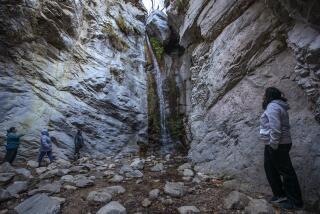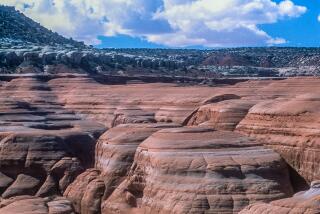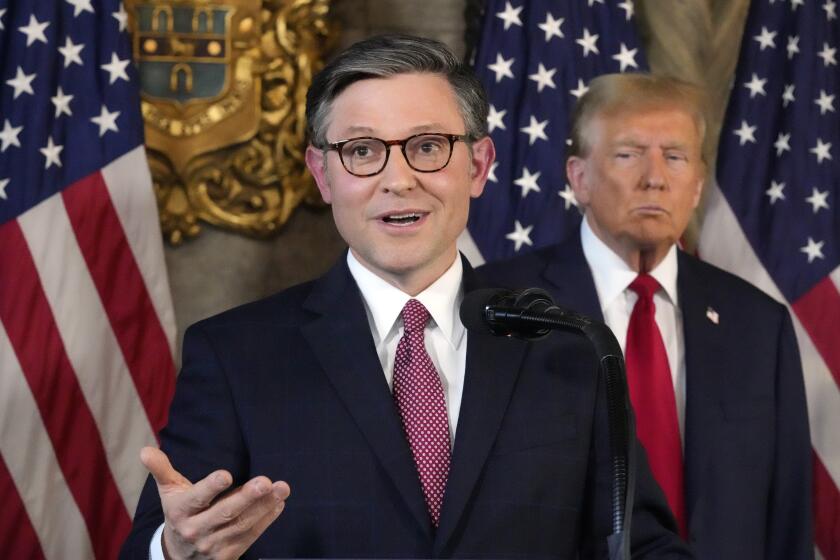Op-Ed: Why is the federal government trading away public land to the 1 percent?
In the battle over public lands, House Republicans recently carried out a raid. In early January, the House approved a small change to the rules dictating how federal land can be transferred to state or local governments, doing away with a requirement that the value of offloaded land be offset in the federal budget.
It’s a detail with far-reaching consequences. Calling the change “outrageous and absurd,” Arizona Rep. Raúl M. Grijalva explained in a letter to fellow Democrats that the revision allows Congress to “give away every single piece of property we own, for free, and pretend we have lost nothing of any value.”
The legitimate concern here is that states are more likely than Washington to sell off public land to private parties. But the truth is that the federal government has been quietly trading away public land for decades — to corporations, developers and, increasingly, wealthy private citizens — through an innocuous-sounding process known as a land exchange.
Land exchanges are swaps between federal agencies, or between federal agencies and a private landowner: I’ll give you this tract if you give me that tract. In theory, exchanges must be in the public interest; a federal agency should agree to one only if it benefits the American people.
The federal government has been quietly trading away public land for decades...through an innocuous-sounding process known as a land exchange.
In recent decades, however, this bureaucratic tool has become a backdoor auction block for the 1%.
One such exchange is pending in Colorado. Leslie Wexner, the Ohio-based billionaire and CEO of the L Brands corporation, the parent company of Victoria’s Secret and Bath & Body Works, is trying to acquire 1,300 acres of public land that sit in the middle of his 4,000-acre estate near Aspen. In return, Wexner would give the public a 557-acre property near a popular recreation area and a 112-acre plot in a trail network used by mountain bikers.
By law, federal agencies must consider the market value of the lands involved before approving a swap. But Wexner’s proposal, as local activists have pointed out, appears to grossly undervalue the land Wexner would be getting, and fails to account for value that would be added to his estate by joining his various properties into one. Wexner has paid more than $15,000 per acre for nearby properties, whereas the proposal values the public land at only $2,500 per acre.
Besides, prior to the proposal, the land Wexner is offering was not on any government wish list, while the land he’s seeking sits at the base of Mt. Sopris, a spectacular 13,000-foot peak.
How does it benefit American citizens if Colorado loses backcountry, and Wexner gets a contiguous estate? With the new land in his holdings, Wexner could turn around and sell the estate for a market-determined price and make a significant profit.
Not all land exchanges invite controversy. In fact, land swaps have long been the means by which public and private landowners consolidate property. They are particularly common in the West, where close to half of all land is public, and where 19th century settlement measures like the Homestead Act resulted in a sometimes illogical patchwork of public and private ownership. Railroad land grants, for instance, which gave railroads alternating square-mile plots along tracks, created an especially unfavorable pattern of ownership still known as “the checkerboards.”
Historically, most land swaps were initiated by the government — to return pockets of private land to the public domain, say, or to consolidate areas overseen by different agencies under the jurisdiction of one. Over time, however, the deals evolved to include large real-estate transactions, and now the majority of exchanges are initiated by private landowners, according to Western Lands Project, a nonprofit that bird-dogs the trades.
Dubious exchanges first made news in the 1990s. In a series titled “Trading Away the West,” the Seattle Times documented a rash of bad swaps across the Pacific Northwest, where, in an effort to consolidate the checkerboards, the Forest Service traded old-growth forest to timber companies in exchange for clear-cuts. Swaps done in the early 1990s in Nevada by the Bureau of Land Management later were found to be obviously disadvantageous. (According to an audit report released by the Interior Department, one trade gave 70 acres valued at $763,000 to a private party who flipped it for $4.6 million on the same day.)
Wexner’s deal represents the latest incarnation of the land exchange, in which wealthy citizens try to acquire vast tracts of public land for their private use. These swaps elicit strong local opposition. In the mid-1990s, a Salt Lake City entrepreneur sought 580 acres of Wyoming’s Targhee National Forest for a family retreat, and, as an opponent told the Seattle Times, “people went ballistic.” The public was similarly riled when, in 2002, an Oregon businessman tried to get 400 acres of the Deschutes National Forest, and in 2004, when an Arizona anesthesiologist sought 15,000 acres of the Prescott National Forest.
Colorado is arguably ground zero for this sort of overreach. One of the first known new-style land exchanges in Wexner’s valley was completed in 1995 by Sue Anschutz-Rodgers, the oil heiress and sister of Philip Anschutz. According to Bureau of Land Management records, Anschutz-Rodgers gave the agency 1,120 acres in exchange for 2,748 acres that sat between her two ranches.
South of Wexner’s estate in 2010, Bill Koch attempted a doozy of a land swap. The energy tycoon and lesser-known brother of the conservative activists David and Charles, Bill Koch tried to get 1,800 acres of public land that divide his 4,500-acre private estate, where he was building an entire Old West town — and he tried to get it quietly, with legislation in Washington. Then it came out that Koch had donated generously to one of the sponsors of his land-swap legislation, former Colorado Rep. John Salazar, and that Salazar had gone on a hunting trip on Koch’s ranch. For these and other reasons, locals firmly opposed the exchange.
The deals sought by Koch and Wexner are the culmination of a singularly manipulative approach to federal land exchanges. Unlike timber companies, which ended up in checkerboard situations, Koch and Wexner appear to have purchased neighboring properties in order to create a buffer of private land around the public land in question. (Wexner spent more than $85 million on 12 different properties, effectively surrounding the public land.) Like Koch, Wexner initially attempted his swap with legislation — the stealthier route, because congressional trades do not require a public comment period. And both deals were brokered by the same well-connected consulting company, Western Land Group, whose exchanges and practices have been questioned in the past.
Three decades of inequitable land exchanges paved the way for the stunning idea implicit in the House Republicans’ rule change: That federal lands quite literally have no value. The private interests who try to acquire public lands through federal exchanges know that they do.
Abby Aguirre is an editor for Opinion. She previously wrote about federal land exchanges for the New Yorker.
Follow the Opinion section on Twitter @latimesopinion or Facebook
MORE FROM OPINION
Trumpcare: Is this what populism looks like?
L.A.’s boutique jails for the rich belong in 18th century England, not modern-day America
Los Angeles needs housing, yes, but not right next to its freeways
President Trump is lucky to be riding a better economic wave than his predecessors caught
More to Read
A cure for the common opinion
Get thought-provoking perspectives with our weekly newsletter.
You may occasionally receive promotional content from the Los Angeles Times.






